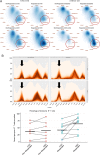High-Parameter Mass Cytometry Evaluation of Relapsed/Refractory Multiple Myeloma Patients Treated with Daratumumab Demonstrates Immune Modulation as a Novel Mechanism of Action
- PMID: 30536810
- PMCID: PMC6590645
- DOI: 10.1002/cyto.a.23693
High-Parameter Mass Cytometry Evaluation of Relapsed/Refractory Multiple Myeloma Patients Treated with Daratumumab Demonstrates Immune Modulation as a Novel Mechanism of Action
Abstract
Daratumumab is a CD38-targeted human monoclonal antibody with direct anti-myeloma cell mechanisms of action. Flow cytometry in relapsed and/or refractory multiple myeloma (RRMM) patients treated with daratumumab revealed cytotoxic T-cell expansion and reduction of immune-suppressive populations, suggesting immune modulation as an additional mechanism of action. Here, we performed an in-depth analysis of the effects of daratumumab on immune-cell subpopulations using high-dimensional mass cytometry. Whole-blood and bone-marrow baseline and on-treatment samples from RRMM patients who participated in daratumumab monotherapy studies (SIRIUS and GEN501) were evaluated with high-throughput immunophenotyping. In daratumumab-treated patients, the intensity of CD38 marker expression decreased on many immune cells in SIRIUS whole-blood samples. Natural killer (NK) cells were depleted with daratumumab, with remaining NK cells showing increased CD69 and CD127, decreased CD45RA, and trends for increased CD25, CD27, and CD137 and decreased granzyme B. Immune-suppressive population depletion paralleled previous findings, and a newly observed reduction in CD38+ basophils was seen in patients who received monotherapy. After 2 months of daratumumab, the T-cell population in whole-blood samples from responders shifted to a CD8 prevalence with higher granzyme B positivity (P = 0.017), suggesting increased killing capacity and supporting monotherapy-induced CD8+ T-cell activation. High-throughput cytometry immune profiling confirms and builds upon previous flow cytometry data, including comparable CD38 marker intensity on plasma cells, NK cells, monocytes, and B/T cells. Interestingly, a shift toward cytolytic granzyme B+ T cells was also observed and supports adaptive responses in patients that may contribute to depth of response. © 2018 The Authors. Cytometry Part A published by Wiley Periodicals, Inc. on behalf of International Society for Advancement of Cytometry.
Trial registration: ClinicalTrials.gov NCT01985126 NCT00574288.
Keywords: CyTOF; cytometry by time of flight; immune profiling.
© 2018 The Authors. Cytometry Part A published by Wiley Periodicals, Inc. on behalf of International Society for Advancement of Cytometry.
Figures






Comment in
-
CyTOF®: A New Tool to Decipher the Immunomodulatory Activity of Daratumumab.Cytometry A. 2019 Apr;95(4):416-418. doi: 10.1002/cyto.a.23752. Epub 2019 Mar 25. Cytometry A. 2019. PMID: 30908843 No abstract available.
References
-
- de Weers M, Tai YT, van der Veer MS, Bakker JM, Vink T, Jacobs DCH, Oomen LA, Peipp M, Valerius T, Slootstra JW, et al. Daratumumab, a novel therapeutic human CD38 monoclonal antibody, induces killing of multiple myeloma and other hematological tumors. J Immunol 2011;186:1840–1848. - PubMed
-
- Lin P, Owens R, Tricot G, Wilson CS. Flow cytometric immunophenotypic analysis of 306 cases of multiple myeloma. Am J Clin Pathol 2004;121:482–488. - PubMed
-
- Santonocito AM, Consoli U, Bagnato S, Milone G, Palumbo GA, Di Raimondo F, Stagno F, Guglielmo P, Giustolisi R. Flow cytometric detection of aneuploid CD38(++) plasmacells and CD19(+) B‐lymphocytes in bone marrow, peripheral blood and PBSC harvest in multiple myeloma patients. Leuk Res 2004;28:469–477. - PubMed
-
- Deaglio S, Mehta K, Malavasi F. Human CD38: A (r)evolutionary story of enzymes and receptors. Leuk Res 2001;25:1–12. - PubMed
-
- Lokhorst HM, Plesner T, Laubach JP, Nahi H, Gimsing P, Hansson M, Minnema MC, Lassen U, Krejcik J, Palumbo A, et al. Targeting CD38 with daratumumab monotherapy in multiple myeloma. N Engl J Med 2015;373:1207–1219. - PubMed
MeSH terms
Substances
Associated data
LinkOut - more resources
Full Text Sources
Medical
Research Materials

